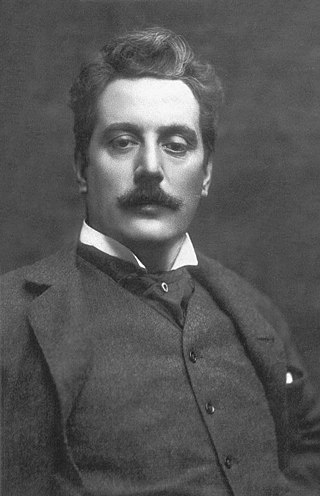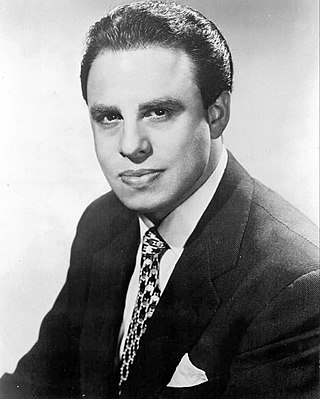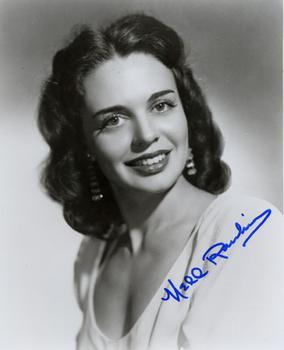A soprano is a type of classical female singing voice and has the highest vocal range of all voice types. The soprano's vocal range (using scientific pitch notation) is from approximately middle C (C4) = 261 Hz to "high A" (A5) = 880 Hz in choral music, or to "soprano C" (C6, two octaves above middle C) = 1046 Hz or higher in operatic music. In four-part chorale style harmony, the soprano takes the highest part, which often encompasses the melody. The soprano voice type is generally divided into the coloratura, soubrette, lyric, spinto, and dramatic soprano.
A tenor is a type of classical male singing voice whose vocal range lies between the countertenor and baritone voice types. It is the highest male chest voice type. Composers typically write music for this voice in the range from the second B below middle C to the G above middle C (i.e. B2 to G4) in choral music, and from the second B flat below middle C to the C above middle C (B♭2 to C5) in operatic music, but the range can extend at either end. Subtypes of tenor include the leggero tenor, lyric tenor, spinto tenor, dramatic tenor, heldentenor, and tenor buffo or spieltenor.
A baritone is a type of classical male singing voice whose vocal range lies between the bass and the tenor voice-types. The term originates from the Greek βαρύτονος (barýtonos), meaning "heavy sounding". Composers typically write music for this voice in the range from the second F below middle C to the F above middle C (i.e. F2–F4) in choral music, and from the second G below middle C to the G above middle C (G2 to G4) in operatic music, but the range can extend at either end. Subtypes of baritone include the baryton-Martin baritone (light baritone), lyric baritone, Kavalierbariton, Verdi baritone, dramatic baritone, baryton-noble baritone, and the bass-baritone.
A contralto is a type of classical female singing voice whose vocal range is the lowest female voice type.

In opera, verismo, from vero, meaning 'true', was a post-Romantic operatic tradition associated with Italian composers such as Pietro Mascagni, Ruggero Leoncavallo, Umberto Giordano, Francesco Cilea and Giacomo Puccini.

Mario Del Monaco was an Italian operatic tenor.

Renata Tebaldi was an Italian lirico-spinto soprano popular in the post-war period, and especially prominent as one of the stars of La Scala, San Carlo and, especially, the Metropolitan Opera. Often considered among the great opera singers of the 20th century, she focused primarily on the verismo roles of the lyric and dramatic repertoires. Italian conductor Arturo Toscanini called her voice "la voce d'angelo", and La Scala music director Riccardo Muti called her "one of the greatest performers with one of the most extraordinary voices in the field of opera."

Renata Scotto was an Italian soprano, opera director, and voice teacher. Recognised for her sense of style, her musicality, and as a remarkable singer-actress, Scotto is considered to have been one of the preeminent opera singers of her generation.

Sherrill Milnes is an American dramatic baritone most famous for his Verdi roles. From 1965 until 1997 he was associated with the Metropolitan Opera. His voice is a high dramatic baritone, combining good legato with an incisive rhythmic style.
The German Fach system is a method of classifying singers, primarily opera singers, according to the range, weight, and color of their voices. It is used worldwide, but primarily in Europe, especially in German-speaking countries and by repertory opera houses.
Spinto is a vocal term used to characterize a soprano or tenor voice of a weight between lyric and dramatic that is capable of handling large musical climaxes in opera at moderate intervals.

George London was an American concert and operatic bass-baritone.

Nell Rankin was an American operatic mezzo-soprano. Though a successful opera singer internationally, she spent most of her career at the Metropolitan Opera, where she worked from 1951 to 1976. She was particularly admired for her portrayals of Amneris in Verdi's Aida and the title role in Bizet's Carmen. Opera News said, "Her full, generous tone and bold phrasing, especially in the Italian repertory, were unique among American mezzos of her generation.

Carmen Melis was an Italian operatic soprano who had a major international career during the first four decades of the 20th century. She was known, above all, as a verismo soprano, and was one of the most interesting singing actresses of the early 20th century. She made her debut in Novara in 1905 and her career rapidly developed in her native country over the next four years. From 1909 to 1916 she performed with important opera companies in the United States; after which she was busy performing at many of Europe's most important opera houses. From 1917 until her retirement from the stage in 1935 she was particularly active at the Teatro Costanzi in Rome and at La Scala in Milan. After her singing career ended, she embarked on a second career as a voice teacher. Her most notable student was soprano Renata Tebaldi.
Alberto Erede was an Italian conductor, particularly associated with operatic work.
A spinto soprano is a type of operatic soprano voice that has the limpidity and easy high notes of a lyric soprano, yet can be "pushed" on to achieve dramatic climaxes without strain. This type of voice may also possess a somewhat darker timbre than the average lyric.
A dramatic soprano is a type of operatic soprano with a powerful, rich, emotive voice that can sing over, or cut through, a full orchestra. Thicker vocal folds in dramatic voices usually (but not always) mean less agility than lighter voices but a sustained, fuller sound. Usually this voice has a lower tessitura than other sopranos, and a darker timbre. They are often used for heroic, often long-suffering, tragic women of opera. Dramatic sopranos have a range from approximately low A (A3) to "high C" (C6). Some dramatic sopranos, known as Wagnerian sopranos, have an exceptionally big voice that can assert itself over a large orchestra (of more than 80 or even 100 players). These voices are substantial, often denser in tone, extremely powerful and, ideally, evenly balanced throughout the vocal registers. Wagnerian sopranos usually play mythic heroines. Successful Wagnerian sopranos are rare and often Wagnerian roles are performed by Italianate dramatic sopranos.

Gianni Poggi was an Italian tenor, particularly associated with the Italian repertory.
A bass is a type of classical male singing voice and has the lowest vocal range of all voice types. According to The New Grove Dictionary of Opera, a bass is typically classified as having a vocal range extending from around the second E below middle C to the E above middle C (i.e., E2–E4). Its tessitura, or comfortable range, is normally defined by the outermost lines of the bass clef. Categories of bass voices vary according to national style and classification system.

Antonio Salvarezza was an Italian tenor.









